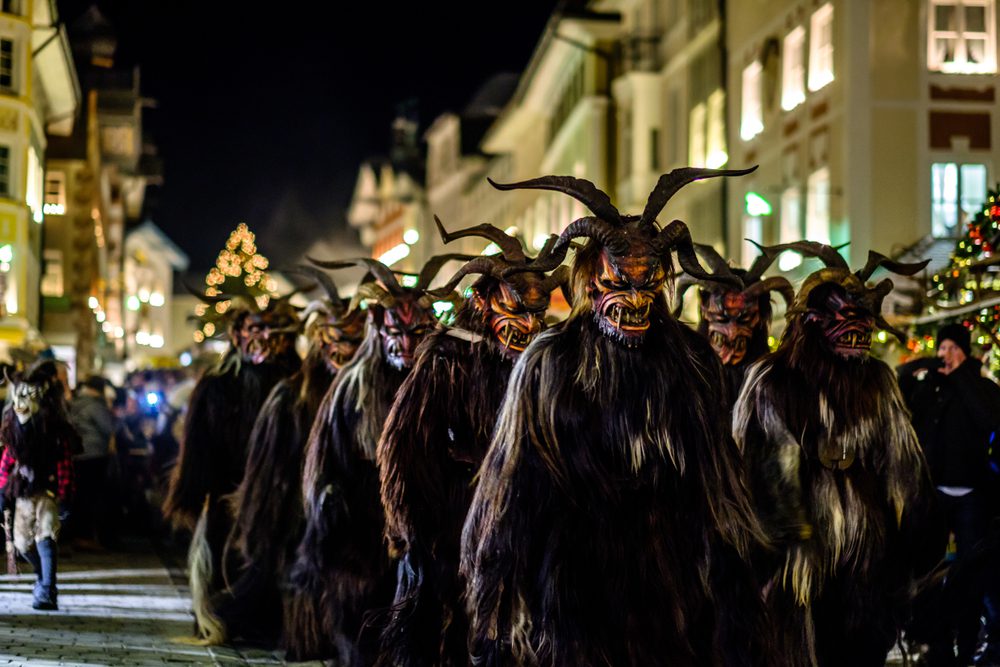Christmas is a time that tries its best to lift the spirits in the bleak mid-winter. We can forget about the constant colds and the desperate dark weather to enjoy festivity, fun, and thoughtfulness. However, some cultures like to remember that this transitional time of year isn’t all jingle bells and mulled wine. Pull back the glittery lights and you might find that something very dark lurks around the spirit of Christmas.
His name is Krampus. A half-goat, half-man with curled horns and a demonic face, Krampus is a figure who’s haunted the nightmares of children (and probably a fair few adults) in Central Europe for centuries.
His primary job is to find and punish the children who have misbehaved the previous year. Acting as the “bad cop” to Saint Nicholas, the pair visit children on the night of December 6, a day known as Krampusnacht.
While those who were good will receive modest gifts of fruit, nuts, and chocolate from Santa, those who were naughty will receive a lashing from Krampus.
“In central Europe, if you have been good – well done you! You’ll be visited by St Nicholas/Santa Claus on December 6th. But if you’ve been bad, Krampus will arrive the night before, to punish you instead,” Deborah Hyde, a cultural anthropologist with an interest in folklore, told IFLScience.
“He’s a hairy creature with goat horns, cloven hooves, and a lolling tongue, and he’s weighed down with rusty chains and bells. He carries a birch stick to strike naughty children and a sack to carry the very worst ones away. If you leave some Schnapps out for him, he might be kinder to you.”
A traditional krampusnacht haunts the streets in Bad Toelz, Germany. Image credit: FooTToo/Shutterstock.com
The name Krampus is said to have originated from the German word Krampen, which means “claw.” The legend of this man-beast is still enjoyed across Germany, Austria, and much of the Alpine region, roughly where the Holy Roman Empire once stood. Krampusnacht is still celebrated too, often in the form of a bustling street festival where boozed-up men dress up as the demon-like figure and frighten onlookers.
His origins can be found deep in the pre-Christian past of Europe, drawing on influences of paganism and Norse mythology. Once Christianity settled in Central Europe and became the dominant religion, Krampus started to become frowned upon. Even beyond his demonic appearance, he appeared to represent the chaotic and “uncivilized” traditions of pagans, not the solemn and pure traditions of Christianity. When fascism caught on in Central Europe during the first half of the 20th century, they were equally displeased with the idea of celebrating this chaotic beast.
Simultaneously, however, Krampus slowly became interwoven with Christan religious practices and concepts of Saint Nicholas, aka Santa Claus.
“With the arrival of Christianity, St Nicholas became the focus of winter festivities. Krampus was successfully absorbed as a less kindly counterpart. The written records only go back a few hundred years but many folklorists think Krampus originates from much earlier,” explained Hyde.
“He may have absorbed elements of the god Odin, who was associated with the Germanic pagan midwinter event of Yule and who led the Wild Hunt, a ghostly procession through the sky. It’s worth remembering that our Father Christmas rides on a sleigh through the air.”
Modern incarnations of Krampus can still see him take on some of these Christian motifs. For instance, when he started appearing on postcards in the 19th century, he was often depicted as being bedraggled in chains, as if to symbolize he was a fallen angel or a demon who was being bound by the Church.
“The pre-Christian and Christian elements of European winter festivals successfully melded hundreds of years ago,” continued Hyde.
“Krampus and his companions often have an injury or an imperfection which has led them to be identified as the Devil,” she noted. “This strand of belief accommodates Christianity very well as it places the Winter Bogeys in the Christian universe. The idea is that anything evil can’t be perfect. There are even strands of fairy folklore which embody this.”
In this sense, Krampus is a bit like the “yin” to Santa’s “yang.” The Joker to Batman. Mario and Wario. That’s why he’s sometimes portrayed as an “evil Santa,” although it’s a little bit deeper than that.
The relationship between Santa Claus and Krampus resonates with the Apollonian and the Dionysian, key concepts in the philosophy of Friedrich Nietzsche. Nietzche looked at the Greek gods Apollo and Dionysus and felt they embodied a universal duality: Apollo is the god of the Sun who represents purity, calmness, and the rational, while Dionysus is the god of wine who represents passion, chaos, and emotion.
It’s not a leap to say that Santa Claus and Krampus are like the festive embodiment of these two poles. Christmas is meant to be a time of peace and generosity, but you should never forget that darkness and chaos can always be lurking around the corner.
Source Link: Who Is Krampus? Meet The Dark Prince Of Christmas Who Kidnaps Kids
